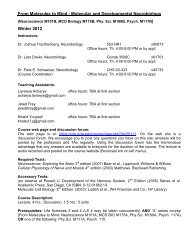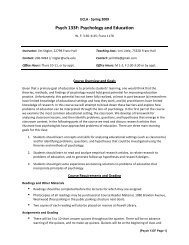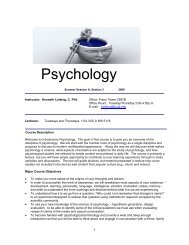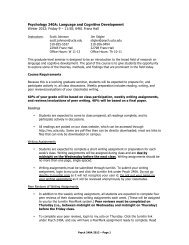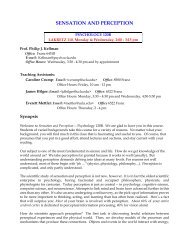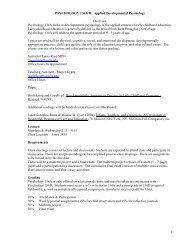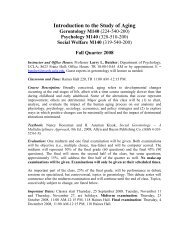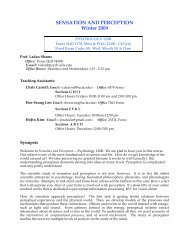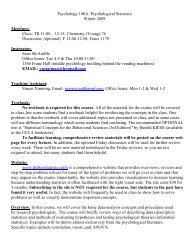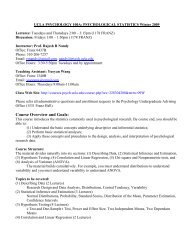SYLLABUS - Courses in Psychology - UCLA
SYLLABUS - Courses in Psychology - UCLA
SYLLABUS - Courses in Psychology - UCLA
Create successful ePaper yourself
Turn your PDF publications into a flip-book with our unique Google optimized e-Paper software.
<strong>SYLLABUS</strong><br />
<strong>Psychology</strong> 126<br />
Cl<strong>in</strong>ical <strong>Psychology</strong> Lab: Cl<strong>in</strong>ical Research Methods<br />
W<strong>in</strong>ter 2009<br />
Tuesday and Thursday, 9:00AM to 10:50AM<br />
Franz Hall A279<br />
Instructor:<br />
Office:<br />
Email:<br />
Office Hours:<br />
Bruce F. Chorpita, Ph.D.<br />
3227 Franz Hall<br />
chorpita@ucla.edu<br />
Thursday 11-12 or by appt.<br />
Teach<strong>in</strong>g Assistant: Christopher Jetton<br />
Office:<br />
5568 Franz Hall<br />
Email:<br />
jetton@psych.ucla.edu<br />
Office Hours: Thursday 11-1<br />
Eligibility<br />
The course is restricted to advanced undergraduate majors <strong>in</strong> psychology who have completed major<br />
requirements <strong>in</strong> research methods and statistics. This course is designed to meet the lab course<br />
requirement of the major for graduation.<br />
This is a designated impacted course, which means that you may not drop the course after the second<br />
week of the quarter.<br />
Goals<br />
The basic goals of the course are to learn or accomplish the follow<strong>in</strong>g:<br />
1. Understand the role of science <strong>in</strong> cl<strong>in</strong>ical psychology<br />
2. Learn basic research methods <strong>in</strong> cl<strong>in</strong>ical psychology, <strong>in</strong>clud<strong>in</strong>g s<strong>in</strong>gle case and randomized<br />
controlled trials<br />
3. Understand empirical reason<strong>in</strong>g as it applies to the practice of psychology<br />
4. Participate <strong>in</strong> the design, data collection, and data <strong>in</strong>terpretation of an experimental group design<br />
5. Participate <strong>in</strong> the cod<strong>in</strong>g of and critique of an exist<strong>in</strong>g experiment <strong>in</strong> the cl<strong>in</strong>ical psychology<br />
literature<br />
6. Participate <strong>in</strong> the cod<strong>in</strong>g of cl<strong>in</strong>ical practices <strong>in</strong> the context of a research trial<br />
7. Formulate and implement a s<strong>in</strong>gle case study: design the study, collect data, and <strong>in</strong>terpret the<br />
results
Required Text<br />
Kazd<strong>in</strong>, A. E. (2003). Research Design <strong>in</strong> Cl<strong>in</strong>ical <strong>Psychology</strong>, Fourth edition. Boston, MA; Alyn & Bacon.<br />
We will place copies of this book on reserve <strong>in</strong> the biomed library.<br />
Grad<strong>in</strong>g<br />
1. Class attendance and PARTICIPATION: 15% of grade<br />
2. Completion of assignments for <strong>in</strong>-class experiment and cod<strong>in</strong>g exercises: 15% of grade<br />
3. Written evaluation of coded paper: 20% of grade<br />
4. Written report of your s<strong>in</strong>gle case study: 30% of grade<br />
5. Presentation of your s<strong>in</strong>gle case study: 20% of grade<br />
Requirements for Evaluation of Coded Paper<br />
Your evaluation must be 2-4 pages, double-spaced, 12-po<strong>in</strong>t font, with 1” marg<strong>in</strong>s. It should be<br />
based on the cod<strong>in</strong>g performed <strong>in</strong> class and should focus on what you see as the major strengths<br />
and weaknesses of the study from a research design perspective.<br />
Requirements for Paper<br />
Your paper must be 10-12 pages, double-spaced, 12-po<strong>in</strong>t font, with 1” marg<strong>in</strong>s, presented <strong>in</strong> the<br />
standard format of the American Psychological Association, with the standard sections of a Title Page,<br />
Abstract, Introduction, Methods, Results, Discussion, References and Tables/Figures. An example of<br />
page allocation is one half page for Abstract, 2 pages for Introduction, 1 page for Methods, 2 pages<br />
for Results, 2 pages for Discussion, 1 page for References, 1 page for Tables/Figures. The<br />
Introduction must present a background and rationale that <strong>in</strong>cludes at least 3 research articles<br />
relevant to your study; the Methods must <strong>in</strong>clude a detailed statement of s<strong>in</strong>gle case design,<br />
procedures (<strong>in</strong>tervention strategies) and measures (dependent variables); the Results must <strong>in</strong>clude<br />
graphical and/or table display of the data; and the Discussion must <strong>in</strong>clude a summary of the results,<br />
<strong>in</strong>terpretation of the results, consideration of the f<strong>in</strong>d<strong>in</strong>gs <strong>in</strong> relation to exist<strong>in</strong>g research, the<br />
limitations to the f<strong>in</strong>d<strong>in</strong>gs (i.e., <strong>in</strong>ternal validity, external validity, dependent variables, confounds),<br />
and directions for future research.<br />
Requirements for Presentation<br />
Your presentation must use visual aids (powerpo<strong>in</strong>t, handouts) to show the practices used and the<br />
progress observed <strong>in</strong> your s<strong>in</strong>gle case study. It should outl<strong>in</strong>e: (1) the problem, (2) studies relevant<br />
to its treatment, (3) <strong>in</strong>terventions chosen, (4) evaluation design and measures, (5) results, and (6)<br />
<strong>in</strong>terpretation. The presentation should be about 10-12 m<strong>in</strong>utes, and it can be as few as 6 slides<br />
cover<strong>in</strong>g the topics above.
Date Topic Assignments<br />
Tues, January 06<br />
Introduction<br />
Review of syllabus and course goals<br />
Question and answer<br />
None<br />
Thurs, January 08<br />
The Scientific Method<br />
Science and pseudoscience<br />
Skepticism<br />
Sagan (1996) Chapters<br />
1 and 12<br />
Tues, January 13<br />
The Scientist Practitioner Model<br />
History, S<strong>in</strong>gle case experimental designs Kazd<strong>in</strong>, Chapter 10<br />
Thurs, January 15*<br />
Selection of Intervention Topics<br />
Review and approval with TA<br />
No read<strong>in</strong>g, but ideas<br />
due for <strong>in</strong>tervention<br />
Tues, January 20<br />
Between-Group Designs<br />
Kazd<strong>in</strong>, Chapters 2, 6<br />
Thurs, January 22<br />
Between-Group Designs<br />
Kazd<strong>in</strong>, Chapters 7, 13<br />
Tues, January 27*<br />
Cod<strong>in</strong>g of RCT<br />
Guided cod<strong>in</strong>g of RCT <strong>in</strong> class<br />
F<strong>in</strong>d 3 studies related<br />
to your assignment<br />
Thurs, January 29<br />
Tues, February 03<br />
Thurs, February 05<br />
Cod<strong>in</strong>g of Practices<br />
Cod<strong>in</strong>g of protocol description<br />
Cod<strong>in</strong>g of session<br />
Evidence-Based Practices <strong>in</strong><br />
<strong>Psychology</strong><br />
Barlow, Chambless Task Forces<br />
Bridg<strong>in</strong>g the Science-Practice Gap<br />
Search<strong>in</strong>g the child mental health literature<br />
Read 3 studies related<br />
to your assignment<br />
Coded RCT evaluations<br />
due; Chambless &<br />
Hollon (1998); West<strong>in</strong><br />
(2005)<br />
Chorpita & Daleiden (<strong>in</strong><br />
press)<br />
Tues, February 10<br />
Evidence Based Systems and<br />
Reason<strong>in</strong>g<br />
Examples of putt<strong>in</strong>g science to work<br />
Daleiden & Chorpita<br />
(2005)
Date Topic Assignments<br />
Thurs, February 12<br />
Q&A on S<strong>in</strong>gle Case Designs<br />
Br<strong>in</strong>g <strong>in</strong> Dashboards, review of progress so far<br />
Email dashboard to TA<br />
by Wed Feb 11<br />
Tues, February 17<br />
Thurs, February 19<br />
Tues, February 24<br />
Design In-Class Experiment<br />
Select measures; conduct random<br />
assignment<br />
Adm<strong>in</strong>ister Experimental<br />
Intervention<br />
Divide <strong>in</strong>to 2 groups – exposure and cognitive<br />
Presentations 1-6<br />
S<strong>in</strong>gle case design f<strong>in</strong>d<strong>in</strong>gs<br />
Collection of experimental data<br />
None<br />
None<br />
Presentations<br />
Thurs, February 26<br />
Presentations 7-11<br />
S<strong>in</strong>gle case design f<strong>in</strong>d<strong>in</strong>gs<br />
Collection of experimental data<br />
Presentations<br />
Tues, March 03<br />
Presentations 12-17<br />
S<strong>in</strong>gle case design f<strong>in</strong>d<strong>in</strong>gs<br />
Collection of experimental data<br />
Presentations<br />
Thurs, March 05<br />
Presentations 18-22<br />
S<strong>in</strong>gle case design f<strong>in</strong>d<strong>in</strong>gs<br />
Collection of experimental data<br />
Presentations<br />
Tues, March 10<br />
Analyze Data Us<strong>in</strong>g SPSS<br />
Discuss f<strong>in</strong>d<strong>in</strong>gs; bra<strong>in</strong>storm a discussion<br />
section, strengths and weaknesses<br />
None<br />
Thurs, March 12<br />
Q&A; Review<br />
Discussion about graduate school and careers<br />
<strong>in</strong> psychology<br />
F<strong>in</strong>al Papers Due



